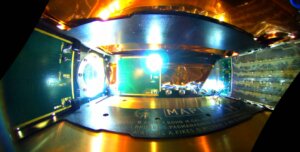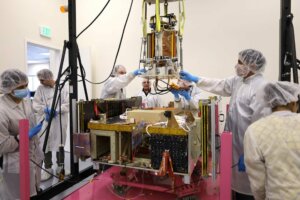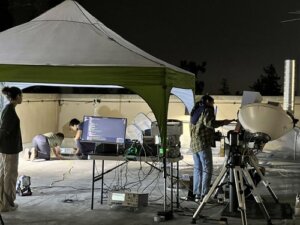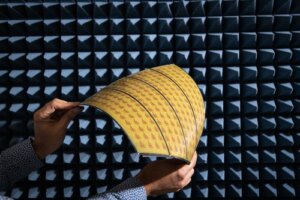|
Getting your Trinity Audio player ready...
|
- Scientists have captured solar energy beamed from a satellite in space
- A big step toward harnessing reliable renewable energy
- Satellites need to be over a kilometer wide to be viable
The events that unfolded following Russia’s invasion of Ukraine in February 2022 sent shockwaves through the energy markets. As natural gas prices soared to record highs and electricity became a luxury in some regions, societies strained under the weight of inflation, poverty, and a slowing economy. While things are steadying, this was a stark reminder of our reliance on fossil fuel providers and the urgent need to shift our attention to more sustainable and secure alternatives.

Interior of MAPLE, with the transmission array to the right and the receivers to the left. Credit: Caltech

Preparing Caltech’s Space Solar Power Demonstrator (SSPD) satellite for launch. Credit: Caltech/Space Solar Power Project
There are still significant problems associated with many renewable energy sources. Those that rely on environmental factors, like wind and solar, fluctuate in their supply so require innovative storage solutions to make them feasible on a large scale. While research continues in this area, scientists at the California Institute of Technology (Caltech) have announced a breakthrough with a slightly different technology. Earlier this month, they revealed they had successfully beamed solar energy from space to a receiver in Pasadena.
This came in the form of microwaves from a satellite called the Space Solar Power Demonstrator (SSPD-1), which was launched on January 3 as part of the Space Solar Power Project (SSPP). SSPD-1 captured the sun’s rays, converted them to electricity, then converted them again into microwaves. These had been transmitted from an array of lightweight microwave power transmitters which make up the Microwave Array for Power-transfer Low-orbit Experiment, or MAPLE. The timing and phase of the radiation emitted by the transmitters can be manipulated so that the beams focus on specific locations on Earth without the use of any moving parts.
Before it sent its first set of microwaves to a rooftop in California, the Caltech scientists ensured the process could survive the harsh environment of space. As well as the transmitter array, MAPLE consists of two separate receiver arrays located about a foot (30cm) away. These were added for a test experiment where microwaves would be directed at them, which they would convert to electricity and light up a pair of LEDs. This was successful, showing for the first time that the entire sequence of wireless energy transmission was possible at a distance.

Detecting power from MAPLE on the roof of Moore Laboratory at Caltech. Credit: Ali Hajimiri
Then, on May 22, a receiver placed on top of the Gordon and Betty Moore Laboratory of Engineering picked up a separate signal which had been sent Earthwards through a window on MAPLE. It came through at the time and frequency predicted by the scientists, demonstrating the technology’s potential.
“In the same way that the internet democratized access to information, we hope that wireless energy transfer democratizes access to energy,” Ali Hajimiri, who led the Caltech team, says. “No energy transmission infrastructure will be needed on the ground to receive this power. That means we can send energy to remote regions and areas devastated by war or natural disaster.”

A prototype antenna sheet for the power transmitter array on the SSPD-1 satellite. Credit: Lance Hayashida/Caltech
The concept of space-based solar power is not a new one, in fact, we’ve been using it for decades with telecommunications satellites. In the same way as SSPD-1, these spacecraft convert solar power into electricity and subsequently microwaves, which are then sent down to antennas that decode the relevant information. The solar panels they are equipped with generate double the power as their Earth-based equivalents. What makes the telecoms processes different from that necessary for transmitting power to the grid are the energy requirements. Space-based solar power systems must operate on a much larger scale and transmit significantly higher power levels to contribute effectively.
The technology that enables this has been a long time coming, but for some time has been too costly to show any real promise. However, in 2017, the first stage of a previously-flown Falcon 9 rocket was sent into space for the second time, proving its reusability. After this milestone, the hypothetical cost of sending a load into space plummeted, and a future powered by satellite solar panels, which provide constant energy 24 hours a day, became much more feasible.
But there are still challenges ahead. The European Space Agency (ESA) says that the solar panels would have to be at least a kilometer wide – ten times larger than the International Space Station – to provide the energy equivalent to a nuclear power station. What’s more, the conversion efficiency of turning electricity into microwaves is currently approximately four times too low to make space-based solar power operationally viable.
Some experts are concerned that the microwave beams produced by these satellites could be weaponized, so they would need an effective safety system to mitigate the risk. There are also concerns about their potential environmental impact. Proper end-of-life management is crucial so they do not add to the ever-growing problem of space debris, but recycling materials on the moon is an option. They may also contribute to significant light pollution in the night sky and disrupt astronomical observations.
Team Caltech remains optimistic, however. Further experiments on board SSPD-1 will test its packing and deployment mechanisms and identify the type of photovoltaic cell that can best endure the punishing conditions of space. There is also an initiative being run by the ESA – SOLARIS – which explores the feasibility of space-based solar power, and the UK government recently awarded £4.3 million to universities and tech companies to fund research.
While we haven’t yet got flying cars or teleportation, this sci-fi solution is steadily becoming a reality.








